On the Prowl for the Elusive Ruffed Grouse
A seasoned group of hunters and their dogs search for the ghost of the forest in Maine’s North Woods.
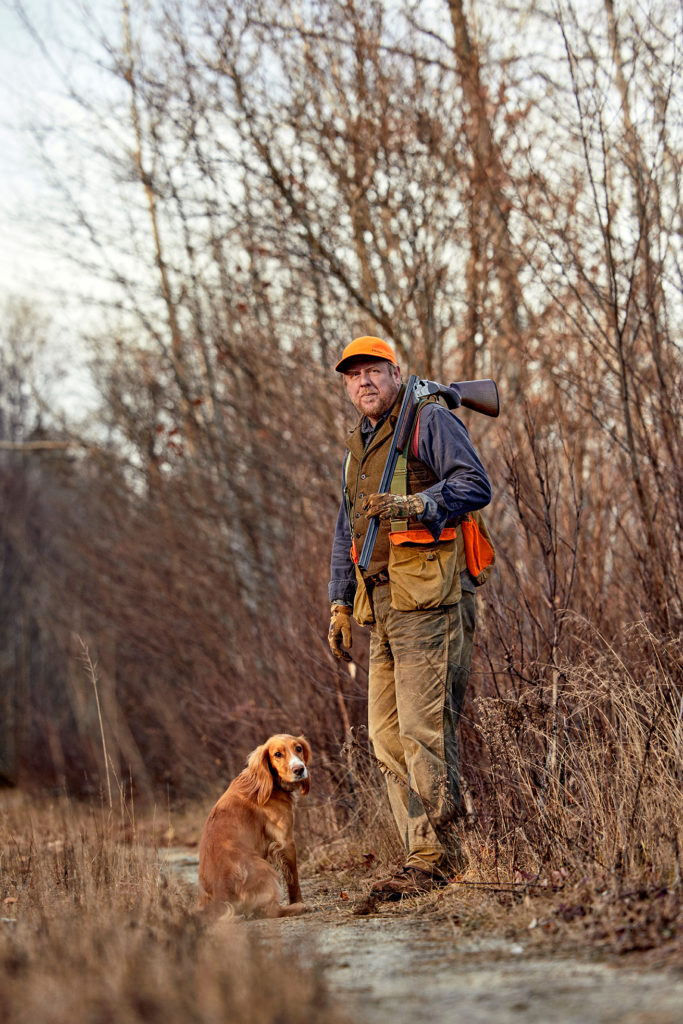
On the Prowl for the Elusive Ruffed Grouse
A seasoned group of hunters and their dogs search for the ghost of the forest in Maine’s North Woods.
by Paul Koenig
Photography by Michael D. Wilson
Issue: November // December 2022
Four English cocker spaniels are running in front of us, blurs of fur and flapping ears disappearing in the woods for a few minutes before reemerging to cross our path. The dogs appear to be following an invisible thread that weaves back and forth through the brush and bare saplings.
It’s late November and barely over freezing. I move the 20-gauge over-under shotgun to my left hand so I can blow warm air on my right, trying to return feeling to my fingers and thumb. We’re about an hour northwest of Bangor, walking on an offshoot of an offshoot that spiders out from Stud Mill Road, a well-maintained gravel logging road that runs parallel to Route 9 from Milford to Washington County.
Jeff McEvoy, the owner of Weatherby’s hunting and fishing camp in Grand Lake Stream, is guiding this trip. He doesn’t have a gun, but he’s armed with a whistle around his neck that he blows to give directions to his dogs—one note to stop, two to move or change direction. McEvoy keeps his eldest dog, Molly, a chocolate cocker spaniel, close because she’s lost her hearing. She isn’t much help, but he still takes her out because this is what his dogs love most: hunting for grouse.


Known by most hunters here as a partridge (or pa’tridge), the ruffed grouse is a plump, brownish gray bird with a ruff of dark feathers around its neck, a black stripe across its tail, and feathers pointing up on its head. It’s the most widely distributed game bird in the United States, but its population has shrunk across the eastern part of the country. Maine is still a stronghold for ruffed grouse, so people travel here every fall to try their luck at shooting the elusive bird.
We’re joined by McEvoy’s son, Carson; client-turned-hunting-buddy David Swayze; and photographer Michael D. Wilson. Swayze is running his own dog, Ellie, a blond English cocker spaniel that’s the daughter of Gus and Curly Fry—McEvoy’s other dogs out with us today—and granddaughter of Molly. English cocker spaniels are flushing dogs, meaning they flush birds, or drive them from their cover. When these dogs catch the scent of a grouse, their nose will be on the ground, and they’ll stop, backtrack, and run in tight circles.
One of the dogs appears to smell something, and suddenly a whoosh of feathers and air shoots out of the brush to our left. Carson, who is walking in front, pulls his gun up and fires a shot, then another. But in a few seconds, the grouse is gone. On our drive in, McEvoy points out habitats that may contain grouse. The forest here is actively managed; trees are regularly harvested, creating early-successional habitat. We’re looking for forests around 10 to 15 years old, with trees as wide as a fist, he says, as he holds up his clenched hand.
Ruffed grouse depend on the food and cover provided by forests that have recently grown back after a disturbance like a cutting or fire. Early-successional species like aspen, birch, alder, and pin cherry tend to grow quickly in areas with a lot of sun, but over time they get taken over by shade-tolerant species like spruce and fir, McEvoy says.
McEvoy has been hunting in this area for decades. He’s seen the forest go through its lifecycles as it’s cut and grows back, all the while waiting for the sweet spots when it’s full of ruffed grouse. “In the moment, an area seems like it will be good forever, but in reality it will only be good for a few years,” he says.
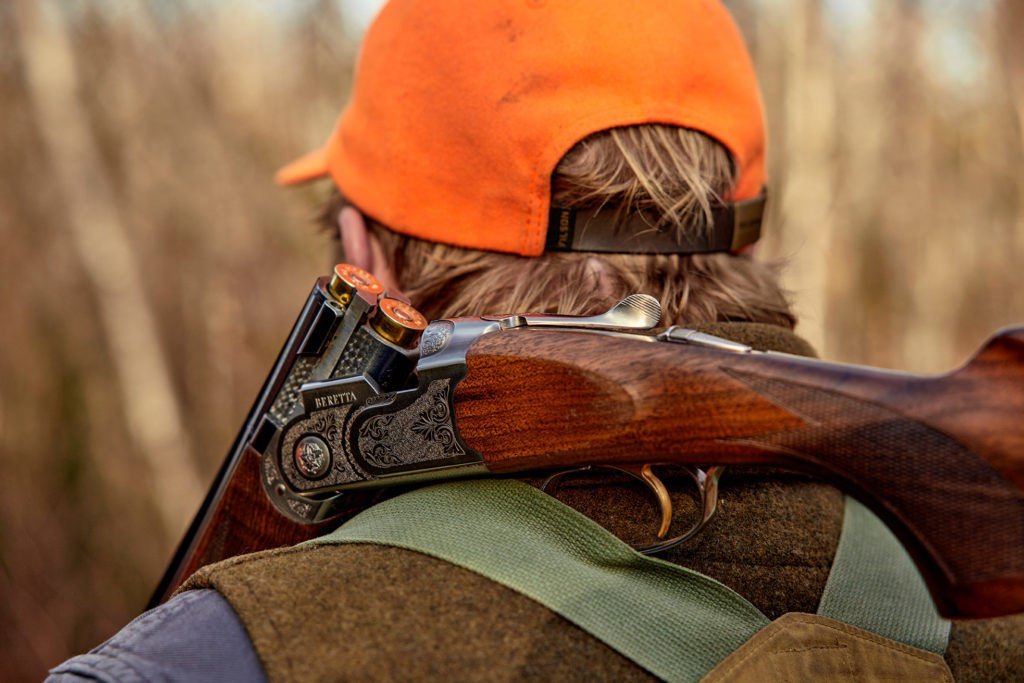
Elsewhere in the eastern U.S., grouse populations have fallen precipitately—at least 50 percent over the past two decades, according to a December 2020 report from the Association of Fish and Wildlife Agencies’ Eastern Grouse Working Group. In the mid-Atlantic region, populations have declined by an average of 84 percent, according to the report, which blamed loss of young forests as the primary driver. Development has fragmented and eliminated habitat across the eastern U.S., while a reduction in forestry management, leaving only mature forest in some areas, has further reduced habitat.
Another emerging threat is the mosquito-borne West Nile virus. States like Maine that still have quality grouse habitat (especially true in Maine’s millions of acres of undeveloped North Woods) can rebound from years with high virus numbers, says Kelsey Sullivan, wildlife biologist for the Maine Department of Inland Fisheries and Wildlife’s Migratory and Upland Game Bird Program.
How you should shoot grouse is a matter of debate among hunters. Some believe that the only sportsmanlike way to kill a grouse is to shoot it when it’s in flight, but there’s a long tradition of driving logging roads in search of grouse and shooting them as they stand. The cultural divide extends to the nomenclature—there’s a saying that it’s “partridge” if shot on the ground and “grouse” if shot on the wing.
The stereotypes of the out-of-state wing-shooter, decked out in pricey gear with an expensive bird dog and expensive side-by-side shotgun, and of the flannel-shirted road-shooter, with an old 12-gauge and a pickup truck, are both grounded in reality, but most hunters don’t fit neatly into those boxes.
“You’re able to put your wits up against the king.”
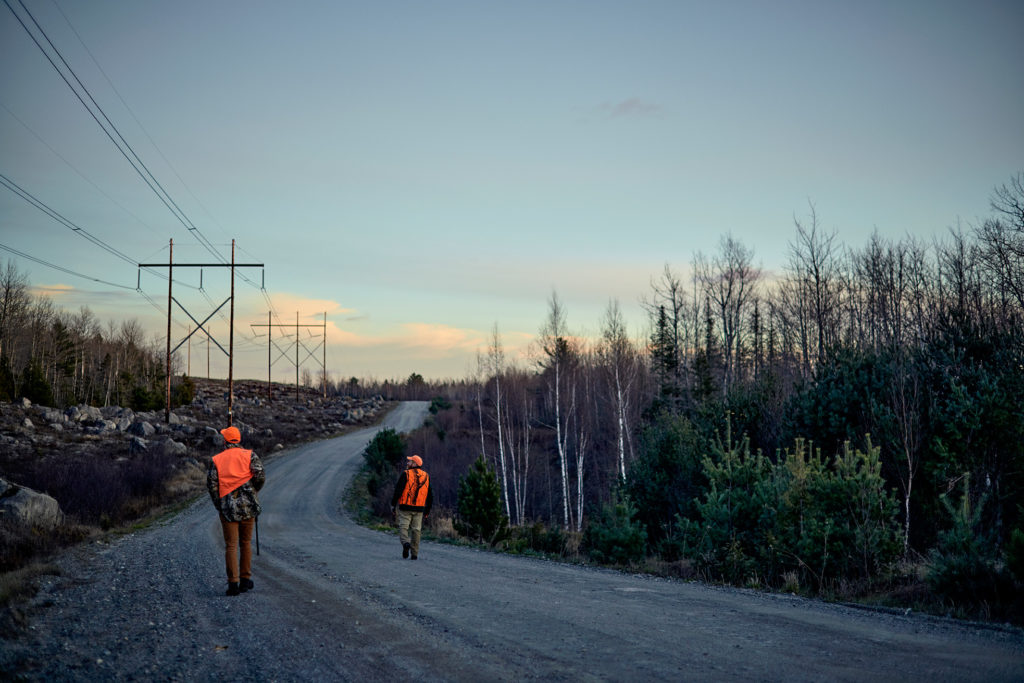
Sullivan says the long-argued debate comes down to personal preference. He recently stopped hunting for grouse, but when he did, he would just hunt from the road. “I’m hunting for the food, so I take what’s available to me, whatever means necessary,” Sullivan says. “If you kill something on the wing it is no different than killing it on the road. To me, it’s the same—you’re killing something.”
McEvoy doesn’t have a problem with ground-shooting, but hunting for him is more about working with his dogs and being outside than killing birds. Most of the time he’s guiding—running his dogs for others—and not hunting. “Raising the dogs, living with the dogs, and sharing my passion with the dogs is what really works for me,” he says. “Now it’s rare I even carry a gun.”
Sam Day, an avid hunter who recently joined the Natural Resources Council of Maine’s board of directors, says he isn’t a purist when it comes to grouse. He’s fine with taking one off the road, but that’s not how he usually hunts. Day grew up grouse hunting but didn’t go more than a few times a year until he got his dog, a German wirehaired pointer named Hank, in spring of 2020. Since then, he’s been hunting with Hank as much as possible, 100 to 120 days a year, for a variety of game, including rabbits, ducks, and upland birds. For Day, getting a grouse is just a cherry on top of a day outside working his dog.
If driving down Millinocket logging roads and shooting “road chickens” is one end of the spectrum, hunting with pointing dogs is the other end. While flushing dogs like McEvoy and Swayze’s spaniels try to get the birds to take to the air, pointing dogs find the grouse and then freeze, or point, with one paw tucked to the side and nose aimed toward the bird. The hunter then must approach where they think the bird is and put themselves in a position to shoot once the grouse takes flight. “It is by far the most technical,” Day says. “Your dog needs to be in their greatest state of critical thinking. To have success they need to analyze their senses in a more nuanced way than anywhere else.”
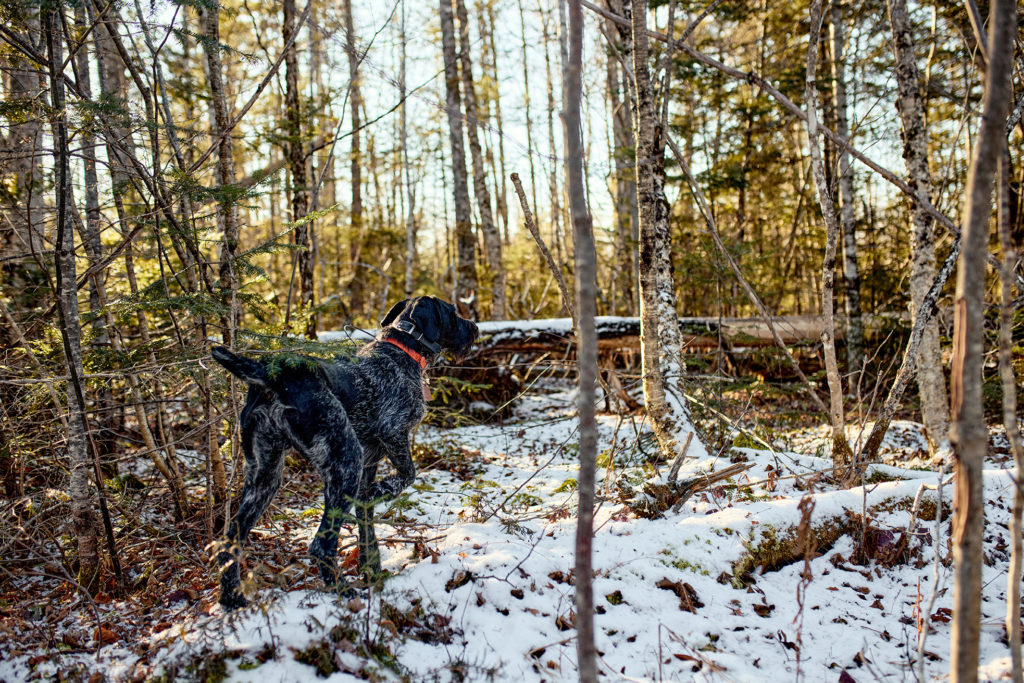
One of Maine’s most prominent pointing dog experts is Jason Carter. His day job is teaching physical education for Regional School Unit 1 in Bath, but he also runs Merrymeeting Kennels in Topsham, which specializes in breeding and training German shorthaired pointers. He’s a judge for the North American Versatile Hunting Dog Association and writes hunting articles for USA Today and other publications. When I told a friend I would be hunting grouse with someone who had German shorthaired pointers, he asked if it was Carter.
The ruffed grouse season runs from the end of September to December 31; most hunters will stop once deer season begins, at the end of October or beginning of November. But, for many bird dog owners like Carter, grouse hunting is a year-round commitment. The hunters are training the high-energy dogs throughout the year, starting when they’re puppies. They’re scouting possible habitats before the start of the season. And, once the season begins, they’re hunting as much as they can and for as long as they can.
“A road hunter is investing in one month,” Carter says. “We’re investing in 12 months.”


Carter’s passion for hunting is based on his love of the grouse, a passion passed down by his mother who, when he was a boy, would pull apart the feathers of birds they shot to show him how to identify the sex. Carter says grouse tend to live in a fairly small area, so they know every possible avenue to escape when you approach them. While the dog stays still as it points to where the bird was, the grouse isn’t going to do the same. You must figure out where the bird most likely is and position yourself to have an unobstructed shot when it takes flight.
“You’re able to put your wits up against the king,” Carter says. “One of the hardest birds to shoot is the grouse. They have amazing survival instincts.”
That’s why Carter feels shooting a grouse in any other way than in flight would cheapen the memory. He was raised to view shooting birds on the ground or in trees as taboo. “There is a lot of value in the process,” he says. “The product of harvesting a grouse is just icing on the cake. We’re more into the process than harvesting the game.”
Carter’s family has had a hunting camp in St. Albans for decades. On former paper company land, the property began as a deer hunting camp for his father, but once his mother and other women started visiting to hunt grouse, everyone else followed suit, and it’s been a grouse camp ever since.
In early December, Carter invited me and Wilson there to hunt with other members of North American Versatile Hunting Dog Association’s Yankee chapter, including Day, whom Carter taught how to train his wirehaired pointer, Hank.
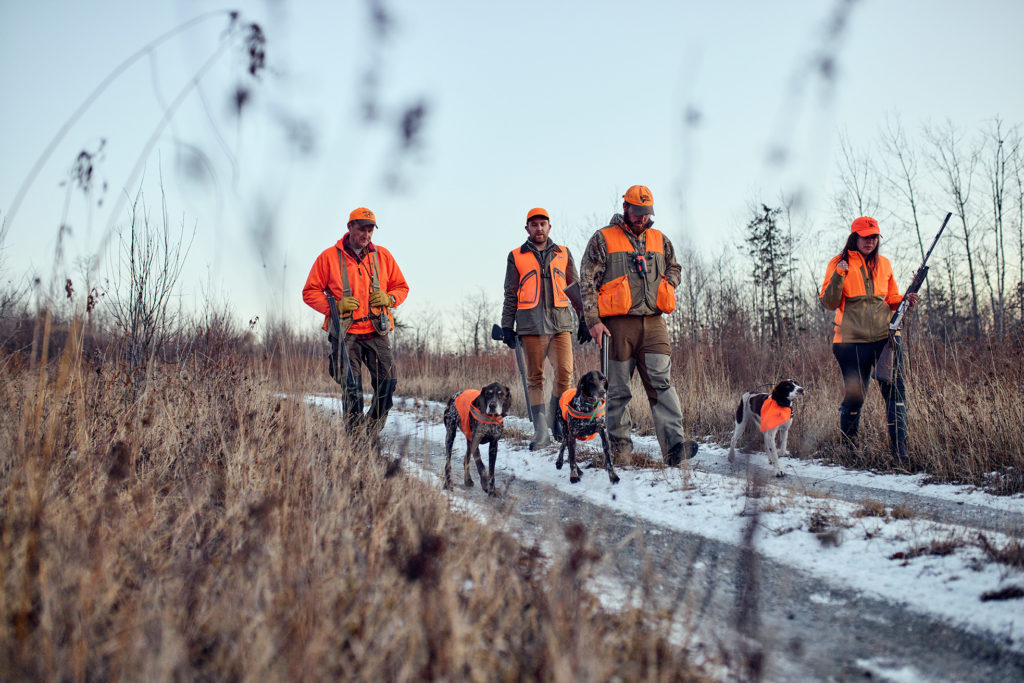
We head out to logging roads to hunt, but before we split up, another hunter, Sarah DeVan, joins us with her one-year-old daughter, Annie, and her German shorthaired pointer, Comet. DeVan and her husband, Stuart, own the 1774 Inn in Phippsburg, and she grew up bird hunting with her parents. When she says she’ll put Annie in the stroller and then grab her gun, I think she’s joking. She’s not, and soon she’s pushing the stroller down the logging road with her gun in hand.
DeVan, who also has a three-year-old son, says Carter taught her how to hunt with her kids because he did the same. When her dog’s collar beeps that he’s on point, she’ll park the stroller and go take her shot. “Being in the woods with them, that feeling of being with your friends and family watching the dogs work, I wanted them to have that from the beginning,” DeVan says.
Carter, Wilson, and I split off to hunt with Carter’s dog, Autumn. Hunting with a pointing dog is different from hunting with a flushing dog because where the dog goes, you go. Instead of running back and forth on the edge of the road like McEvoy’s cocker spaniels, Autumn is going deep into the forest.
The only path we’re following is Autumn’s, and the thick covert of this young forest makes for a challenging hike. After an especially difficult spell of bushwhacking, Carter points out that trees grow toward the sun and create natural corridors. We turn slightly to the left, and I discover he’s right: a path appears in front of us from what was previously a dense mass of trees and brush. “The woods will tell you everything,” he says. “If you walk right, it’s easy.”


At one point, the trees open to an expansive bog. Yellow, elevated tufts of grass stick out from the frozen water and mud and spread out in front of us. “There’s an allure to being out here,” Carter says as he looks out at the landscape. “You’re all alone, and you feel like the only one who’s ever been here before.” He’s right, and as I catch my breath, I think about the journey that brought me to this untouched beauty: leaving my house in southern Maine before the sun rose, driving to Carter’s camp and down logging roads, and following Autumn’s nose through the woods.
We keep walking, and soon Carter’s control beeps. Autumn’s on point. When we move ahead, we see her facing the edge of a massive log—more than 20 feet long and a few feet wide. Carter whispers to me to take a counterclockwise circle around the log so I’ll be able to shoot when the bird flushes from behind it.
As I walk around the log, I feel my heart beating beneath my jacket. My right thumb is firmly pressed against the safety, and my index finger is extended straight against the trigger guard, the shotgun pointed slightly upward, ready to mount it against my shoulder and swing toward the bird.
My ears are alive, and I hear every piece of underbrush and twigs crunching under my Muck boots. My eyes scan the widest field possible while minding the branches and trees around me and trying to keep a clear shooting lane. Then I hear it: the explosion of flapping wings as the grouse takes flight. But it’s coming from behind my right shoulder, not the log in front of me. I spin as I raise the shotgun to my shoulder, sweep the barrel toward the flash of gray, and squeeze the trigger. It’s too late. The grouse escapes by one of its numerous exit points.
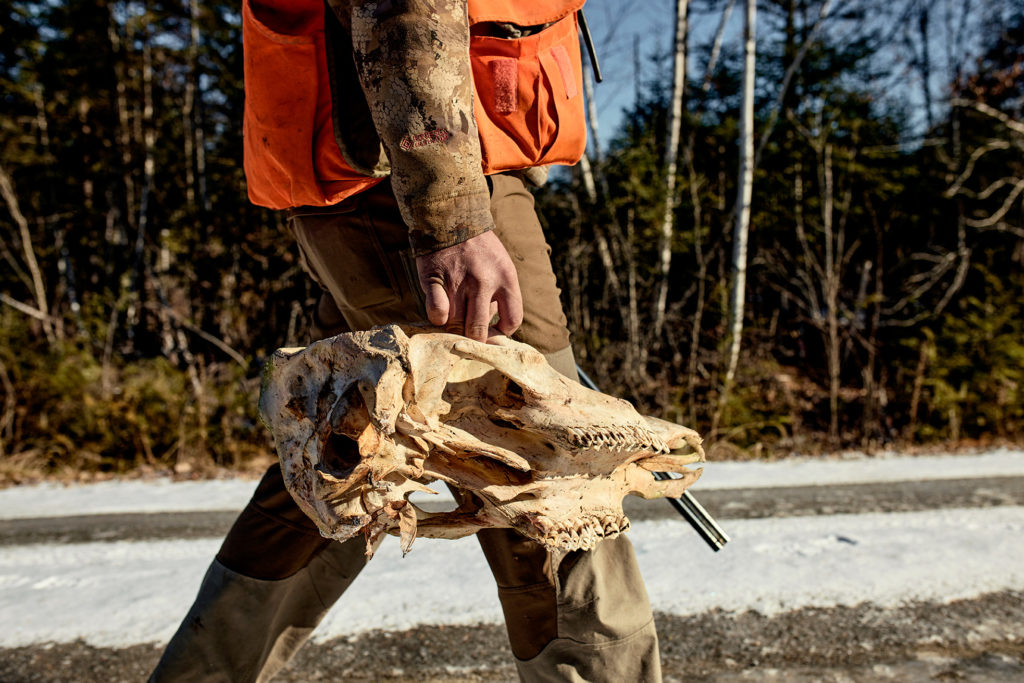
When, months later, I talk to Carter about the day, he recounts it as if it happened yesterday. He tells me that hunting is about the process, not the product. For me to have the opportunity to shoot at that grouse took years of Carter training Autumn, and Carter’s decades of experience in the woods. “Seeing that dog work that grouse so well and being able to put you in the position to shoot a ghost of the forest, that’s everything,” he says.
A week after my hunting trip with Carter, I’m walking my dog, a stocky black Lab named Moose, through a nature preserve in southern Maine. The scenery looks similar to the hunt—smallish, bare trees, a thin layer of crunchy snow beneath my feet—and there is no one but me and Moose on the trails.
I think back to that time in the bog and what Carter told me. Despite my years spent exploring Maine’s outdoors, it’s rare that I “feel like the only one who’s ever been here before”—even now, alone in the woods with my dog. No one else is around us, but there are signs of the people who have been here before me: the worn path beneath my feet, the trail markers on the trees, and the cut logs along the trail.
I miss that time cutting a path through the woods with Carter and his dog. Walking through forests where no one has made a trail, guided by an animal’s nose, following the scent of a bird. A feeling of being the first to discover a place. Except for, of course, the grouse.
Read More:
- Branching Out

- 48 Hours in Cape Elizabeth, South Portland + Scarborough

- 4 Unique Winter Weekends

- Where to Cross-Country Ski This Winter

- Brunswick in 48 Hours


